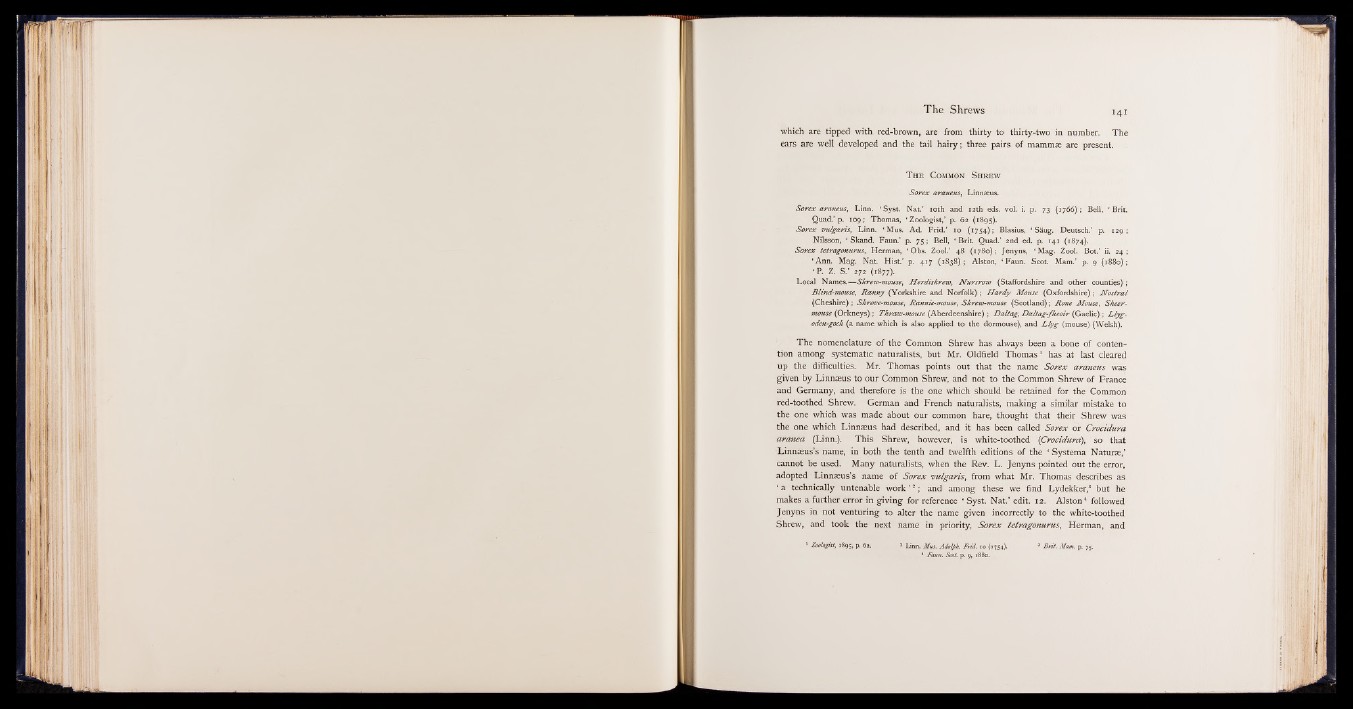
The Shrews 141
which are tipped with red-brown, are from thirty to thirty-two in number. The
ears are well developed and the tail hairy; three pairs of mammae are present.
T h e C o m m o n S h r e w
Sorex araneus, Linnaeus.
Sorex araneus, Linn. ‘ Syst. Nat.’ 10th and 12th eds. vol. i. p. 73 (1766); Bell, ‘ Brit.
Quad.’ p. 109; Thomas, ‘ Zoologist,’ p. 62 (1895).
Sorex vulgaris, Linn. ‘ Mus. Ad. Frid.’ 10 (1754); Blasius, ‘ Saug. Deutsch.’ p. 129 ;
Nilsson, ‘ Skand. Faun.’ p. 75; Bell, ‘ Brit. Quad.’ 2nd ed. p. 141 (1874).
Sorex tetragonurus, Herman, ‘ Obs. Zool.’ 48 (1780); Jenyns, ‘ Mag. Zool. Bot.’ ii, 24;
‘ Ann. Mag. Nat. Hist.’ p. 417 (1838); Alston, ‘ Faun. Scot. Mam.’ p. 9 (1880);
‘ P. Z. S .’ 272 (1877).
Local Names.— Shrew-mouse, Herdiskrew, Nursrow (Staffordshire and other counties) ;
Blind-mouse, Ranny (Yorkshire and Norfolk); Hardy Mouse (Oxfordshire) ; Nostral
(Cheshire); Shrove-mouse, Rannie-mouse, Shrew-mouse (Scotland); Rone Mouse, Sheer-
mouse (Orkneys); Thraw-mouse (Aberdeenshire); Daltag, Daltag-fheoir (Gaelic); Llyg-
oden-goch (a name which is also applied to the dormouse), and Llyg (mouse) (Welsh).
The nomenclature of the Common Shrew has always been a bone of contention
among systematic naturalists, but Mr. Oldfield Thomas1 has at last cleared
up the difficulties. Mr. Thomas points out that the name Sorex araneus was
given by Linnaeus to our Common Shrew, and not to the Common Shrew of France
and Germany, and therefore is the one which should be retained for the Common
red-toothed Shrew. German and French naturalists, making a similar mistake to
the one which was made about our common hare, thought that their Shrew was
the one which Linnaeus had described, and it has been called Sorex or Crocidura
aranea (Linn.). This Shrew, however, is white-toothed (Crocidura), so that
Linnaeus’s name, in both the tenth and twelfth editions of the ‘ Systema Naturae,’
cannot be used. Many naturalists, when the Rev. L. Jenyns pointed out the error,
adopted Linnaeus’s name of Sorex vulgaris, from what Mr. Thomas describes as
‘ a technically untenable work ’ 2; and among these we find Lydekker,8 but he
makes a further error in giving for reference ‘ Syst. Nat.’ edit. 12. Alston4 followed
Jenyns in not venturing to alter the name given incorrectly to the white-toothed
Shrew, and took the next name in priority, Sorex tetragonurus, Herman, and
1 Zoologist, 1895, p. 62. * Linn. Mus. Adolph. Frid. 10 (1754). 3 B rit. Mam. p. 75.
* Faun. Scot. p. 9, 1880.